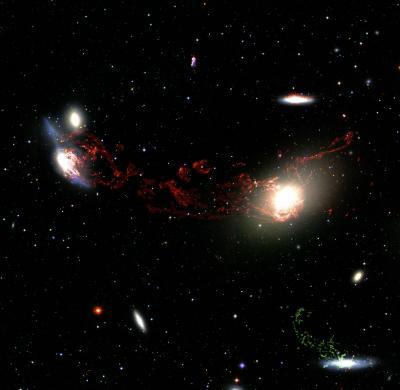According to the article that will be published in the November 2008 issue of The Astrophysical Journal Letters, astronomers study pictures of a nearby cluster of galaxies that have recently discovered evidence of a collision with High speed between large elliptical galaxies may prevent star formation.
Under the direction of Jeffrey Kenny, professor and chair of astronomy at Yale University, the team observed the strange complexity of warm air fibers located 400,000 light-years away, connecting the celestial the M86 elliptical galaxy and the spiral galaxy NGC 4439 in the Virgo galaxy cluster; thereby providing evidence for high-speed collisions among previously suspected galaxies. The photos were taken by the large Mosaic market camera set in the National Science Foundation's telescope at Kitt Peak National Observatory (near Tucson, Arizona).
The main author of the paper, Kenney, said: 'Our data shows that this system represents the most recent collision between a large elliptical galaxy and a large spiral galaxy. The findings provide some of the clearest evidence so far that high-speed intergalactic collisions. It also suggests a possibility of forming black holes that serve as an explanation for stars not being able to form in large galaxies. '
Previously, scientists had observed gas fibers in both galaxies, but they did not detect or infer any links between the two galaxies located about 50 million light-years from Earth. The new image clearly shows fuzzy, spreading air fibers that directly link the two galaxies, but there are no obvious stars.
Among elliptical galaxies, gas in the M86 galaxy is extremely hot, emitting X-rays in a long beam. The previous X-ray beam was explained that the tail of gas was stripped when M86 fell into the Virgo cluster. According to the newly photographed image, most of the disturbing objects in the M86 galaxy are actually generated by the collision with NGC 4438.

Cluster M86-NGC4438: A photograph of a part of the Virgo constellation reveals the twisted helical hydrogen gas located 400,000 light-years away, which connects the M86 elliptical galaxy (right) to the NGC 4438 spiral galaxy (left).The photo was taken with the wide-market camera Mosaic placed in the Mayall telescope 4 meters in diameter at Kitt Peak National Observatory (Natural Science Foundation).(Photo by Tomer Tal and Jeffrey Kenney / Yale University and NOAO / AURA / NSF)
Kenney said: 'The telescope image uses a wide-market camera at Kitt Peak that allows us to get a bigger picture. We need to look deeper and wider to see the M86 complex '.
Currently the unsolved astronomical mystery is a question of the cause of large galaxies in the universe - mostly elliptical galaxies like M86 - to stop star formation. ' Something that heats gas so it can't cool down and form stars. Our research indicates that the gravitational interaction may have caused this. '
According to the authors, small velocity collisions between small galaxies or medium-sized galaxies often speed up star formation in galaxies. But for high-speed collisions that only occur in large galaxies, the energy of the impact causes the gas to heat up so much that the gas cannot cool down easily to form stars.
Kenney added: 'The same natural process occurs in strong and weak encounters. By studying the impact of particular cases such as M86, we can understand the role of gravity in heating up galactic gas. The galactic gas seems to have a rather important role. '
The co-authors of the study include Yale graduate student Tomer Tal (Yale University), Yale University alumni - Hugh Crowl - currently working at the University of Massachusetts, George Jacoby (WIYN observatory director) and John Feldmeier (Youngstown University).
Kitt Peak National Observatory belongs to the National Optical Astronomical Observatory (NOAO) run by the Astronomical Research Association (AURA) under the consent of the National Science Foundation. The co-founders of WIYN Observatory include the University of Wisconsin, Indiana University, Yale University and NOAO.

 Van Allen's belt and evidence that the Apollo 11 mission to the Moon was myth
Van Allen's belt and evidence that the Apollo 11 mission to the Moon was myth The levels of civilization in the universe (Kardashev scale)
The levels of civilization in the universe (Kardashev scale) Today Mars, the sun and the Earth are aligned
Today Mars, the sun and the Earth are aligned The Amazon owner announced a secret plan to build a space base for thousands of people
The Amazon owner announced a secret plan to build a space base for thousands of people